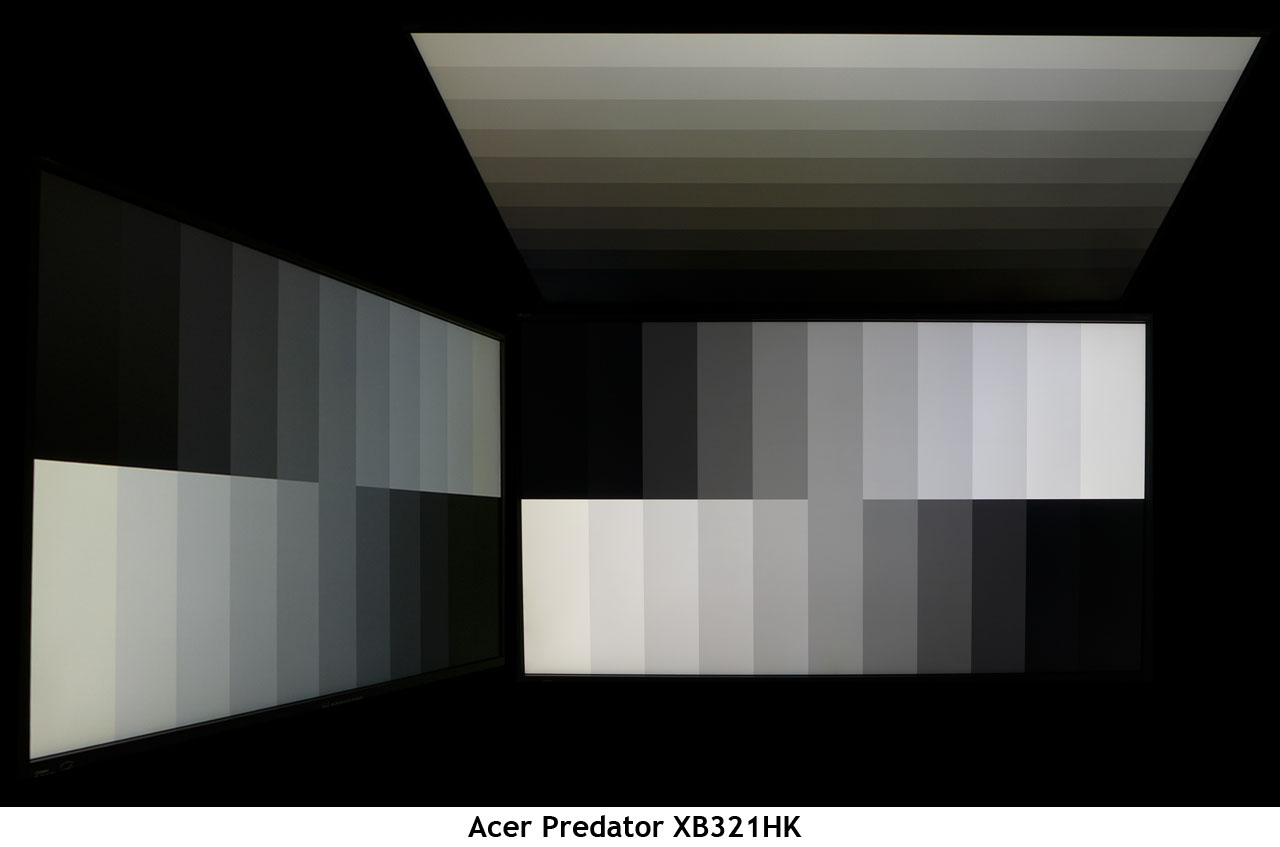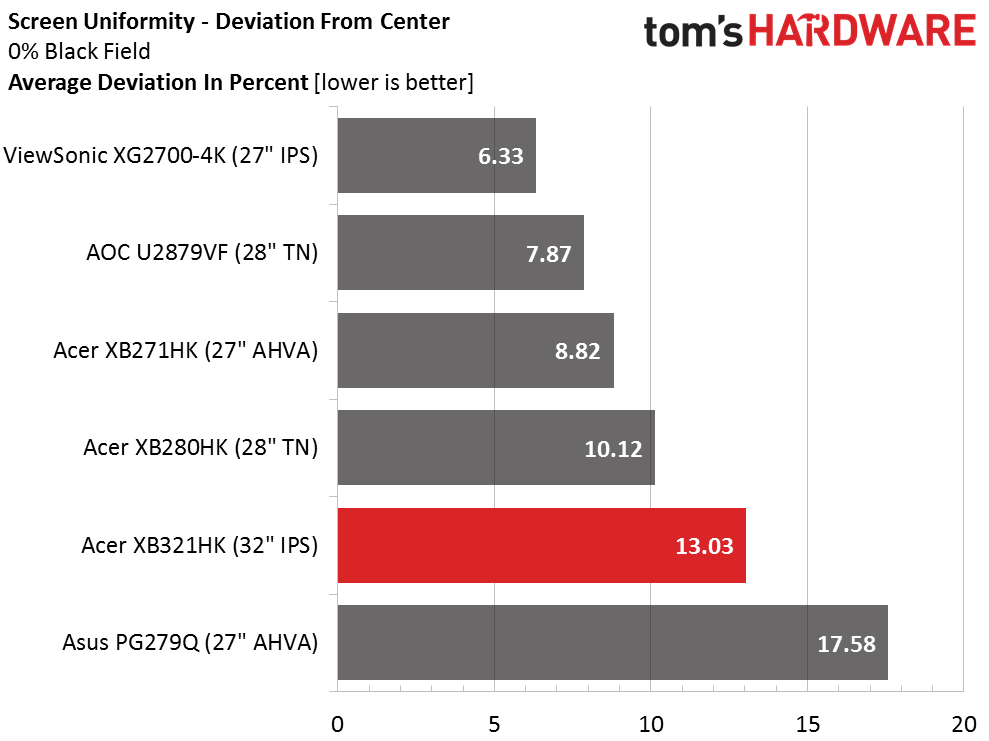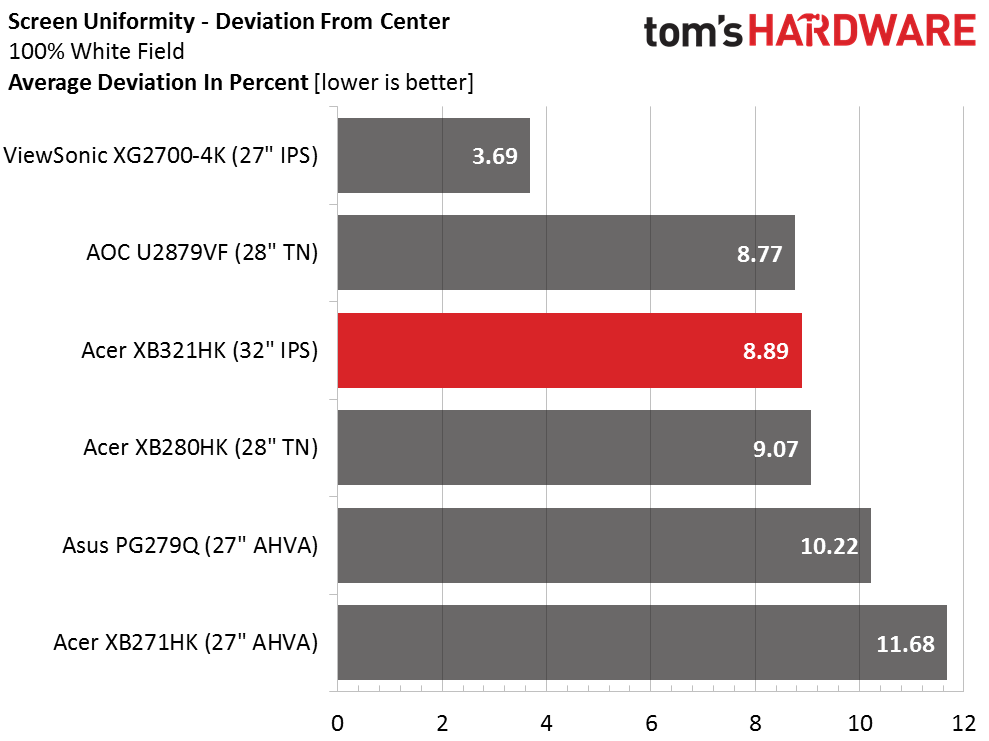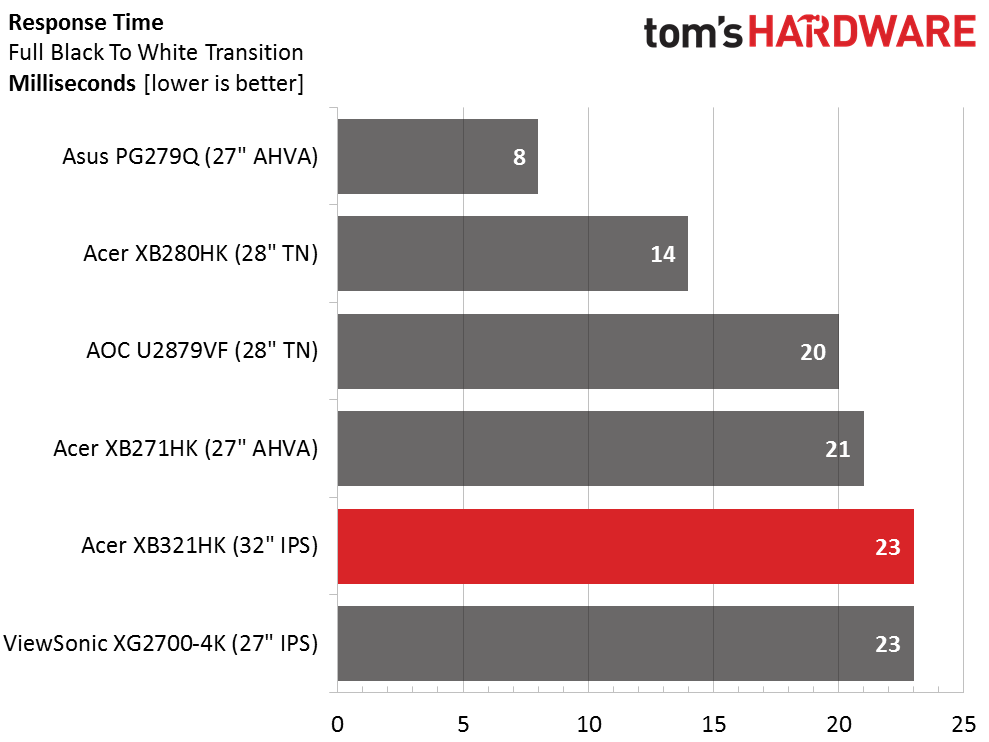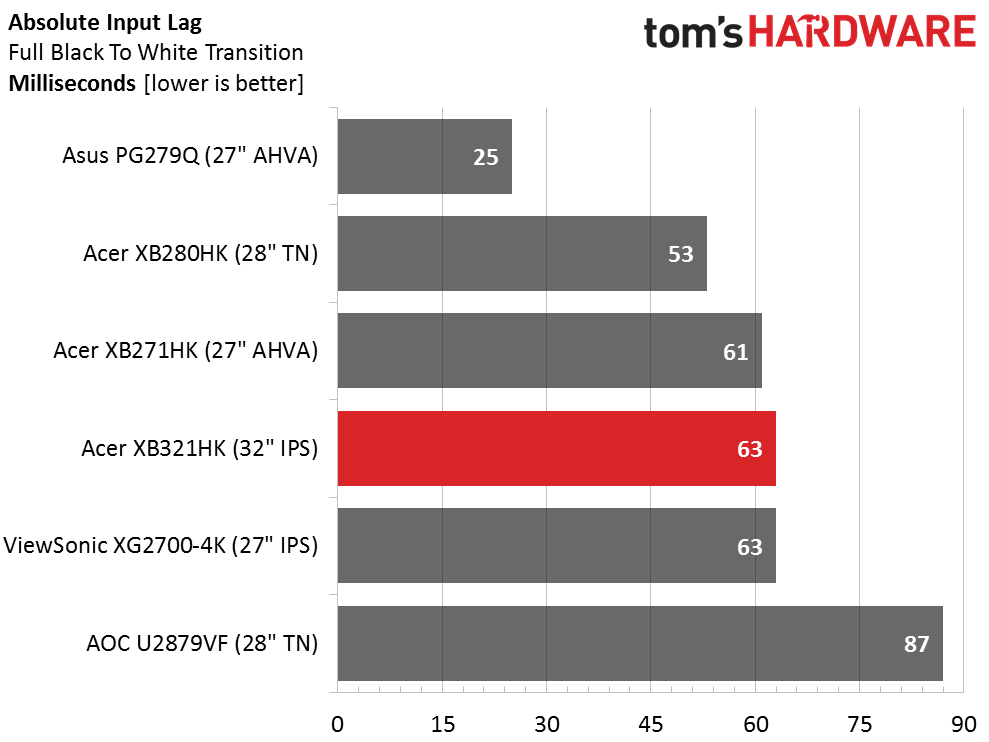Acer Predator XB321HK 32-inch Ultra HD G-Sync Monitor Review
Today we’re looking at Acer’s latest flagship gaming monitor, the Predator XB321HK. Sporting a 32-inch IPS screen, G-Sync and premium build quality; it looks like just the thing for a cost-no-object gaming rig.
Why you can trust Tom's Hardware
Viewing Angles, Uniformity, Response And Lag
To learn how we measure screen uniformity, please click here.
The XB321HK’s tight TFT layer gap not only enhances image clarity, it also improves off-axis quality. These are some of the best viewing angles we’ve seen outside of an AHVA panel. Light falloff is obvious to the sides, but there is only a minimal color shift to blue. From above, detail holds up well and color shifts to warmer tones.
Screen Uniformity: Luminance
Our sample suffered from a minor hotspot in the lower right corner of the screen. It doesn’t qualify as light bleed but we could see it in our test patterns. It doesn’t have much effect on real-world content though.
Here’s the white field measurement.
The white field test returns a solid result of 8.89%. There are no visible issues here and our measurements don’t even indicate the usual center hotspot. This is a well-made panel and though each sample will vary, we don’t expect quality control to be a problem.
Screen Uniformity: Color
Color uniformity is extremely good at only 1.36dE. It’s one of the best scores we’ve recorded, and here it’s only bested by the other Acer Predator display. We are impressed but only as far as to say that one should expect this level of quality from a premium-priced product.
Pixel Response And Input Lag
Please click here to read up on our pixel response and input lag testing procedures.
Get Tom's Hardware's best news and in-depth reviews, straight to your inbox.
The PG279Q has a major advantage stemming from its 165Hz refresh rate. The other screens make do with 60Hz, and it seems the XB280HK makes the most of that with its TN screen. The remaining monitors are so close to one another it’s unlikely anyone would perceive a difference. The XB321HK has an excellent overdrive feature that visibly reduces motion blur while introducing only slight ghosting artifacts.
Here are the lag results.
In our test, 63ms is a great score for a 60Hz display. We don’t think input lag will be a problem with any of the top five screens, even for skilled players. Of course the lowest latency still comes from the higher refresh rates offered by QHD- and FHD-resolution monitors.
Gaming With G-Sync
While we haven’t noted significant differences in the gaming experiences between various high-end monitors, the XB321HK provided us a stunning example of just how good a game can look. Even before we talk about things like G-Sync and motion blur, the beautiful bright color and rich detail possible with this monitor is something that has to be seen to be appreciated. Trust us, when you load up eye-candy like Far Cry 4 or Tomb Raider, you won’t care how much it costs.
The demands of Far Cry 4 required us to play in Very High detail mode with our usual GTX Titan X-equipped system. We certainly didn’t notice any lack of clarity or fine textures. Not only was motion completely free of artifacts, we were able to run the overdrive on Extreme without any visible ghosting. Just standing still while trees moved with the wind provided a fantastic suspension of disbelief. Framerates stayed in the 40-50fps range, and that provided sufficient smoothness for us to play the game well, even when the action got fast and furious.
Battlefield 4, being somewhat less-demanding, could be played on Ultra Detail with framerates just below 60fps. Its high-contrast outdoor areas managed to survive the overdrive’s Extreme setting without ghosting. And G-Sync made sure that vertical edges like buildings and light poles remained in one piece.
Tomb Raider looked awesome played on High detail with no loss of quality and a framerate locked on 60fps. This is about as smooth as an Ultra HD monitor is going to get until DisplayPort 1.3 with its 120Hz capability becomes more common. There was no ghosting here either. We’re happy to see that the XB321HK has one of the best overdrive implementations we’ve experienced. Action stays smooth and solid with barely any blur and of course, no tearing. The big Predator’s price tag may be high but with this display, you truly get what you pay for.
Current page: Viewing Angles, Uniformity, Response And Lag
Prev Page Color Gamut And Performance Next Page Conclusion
Christian Eberle is a Contributing Editor for Tom's Hardware US. He's a veteran reviewer of A/V equipment, specializing in monitors. Christian began his obsession with tech when he built his first PC in 1991, a 286 running DOS 3.0 at a blazing 12MHz. In 2006, he undertook training from the Imaging Science Foundation in video calibration and testing and thus started a passion for precise imaging that persists to this day. He is also a professional musician with a degree from the New England Conservatory as a classical bassoonist which he used to good effect as a performer with the West Point Army Band from 1987 to 2013. He enjoys watching movies and listening to high-end audio in his custom-built home theater and can be seen riding trails near his home on a race-ready ICE VTX recumbent trike. Christian enjoys the endless summer in Florida where he lives with his wife and Chihuahua and plays with orchestras around the state.
-
Bartendalot The nite about 4K@60hz being obsolete soon is a valid one and makes the purchase price even more difficult to swallow.Reply
I'd argue that my 1440p@144hz is a more future-proof investment. -
Yaisuah I have this monitor and think its great and almost worth the money, but I want to point out that nobody on the internet seems to realize there's a perfect resolution between 1440 and 4k that looks great and runs great and I think it would be considered 3k. Try adding 2880 x 1620 to your resolutions and see how it looks on any 4k monitor. I run windows and most less intensive games at this resolution and constantly get 60fps with a 970(around 30fps at 4k). You also don't have to mess with windows scaling on a 32in monitor. After seeing how great 3k looks and runs, I really don't know why everyone immediately jumped to 4k.Reply -
mellis I am still going to wait before getting a 4K monitor, since there is still not a practical solution for 4K gaming. In a couple of more years hopefully 4K monitors will be cheap and midrange GPUs will be able to support gaming on them. I think trying to invest in 4K gaming now is a wait of money. Sticking with 1080p for now.Reply -
truerock A 4K@120Hz G-Sync video monitor based PC rig under $4,000 is probably 2 to 3 years away.Reply -
RedJaron Reply
I would hazard a few guesses. First would be that 2880x1620 is so close to 2560x1440 that no manufacturer wants to complicate product lines like that.18346905 said:I have this monitor and think its great and almost worth the money, but I want to point out that nobody on the internet seems to realize there's a perfect resolution between 1440 and 4k that looks great and runs great and I think it would be considered 3k. Try adding 2880 x 1620 to your resolutions and see how it looks on any 4k monitor. I run windows and most less intensive games at this resolution and constantly get 60fps with a 970(around 30fps at 4k). You also don't have to mess with windows scaling on a 32in monitor. After seeing how great 3k looks and runs, I really don't know why everyone immediately jumped to 4k.
Second, 2160 is the least common multiple of both 720 and 1080, meaning it's the lowest resolution that's a perfect integer scalar of both. So with proper upscaling, a 720 or 1080 source picture can be displayed reasonably well on a 4K display. These panels are made for TVs as well as computer monitors, and the majority of TV signal ( at least in the US ) is still in either 720p or 1080p. Upscaling 1080 to 1620 is the same as upscaling 720 to 1080 ( they're both a factor of 150% ). Upscaling by non-integer factors means you need a lot of pixel interpolation and anti-aliasing. To me, this looks very fuzzy ( I bought a 720p TV over a 1080 TV years ago because playing 720p PS3 games and 720p cable TV on a 1080p display looked horrible to me ). So it may be the powers that be decided on the 4K resolution so that people could adopt the new panels and still get decent picture quality with the older video sources ( at least until, or if, they get upgraded ). If so, I can agree with that. -
michalt I have one and have not regretted my purchase for a second. I tend to keep monitors for a long time (my Dell 30 inch displays have been with me for a decade). When looked at over that time period, it's not that expensive for something I'll be staring at all day every day.Reply -
photonboy It would be nice to offer a GLOBAL FPS LOCK to stay in asynchronous mode at all times regardless how high the FPS gets.Reply -
photonboy Update: AMD has this, not sure where it is for NVidia or if the GLOBAL FPS LOCK is easy to do.Reply
